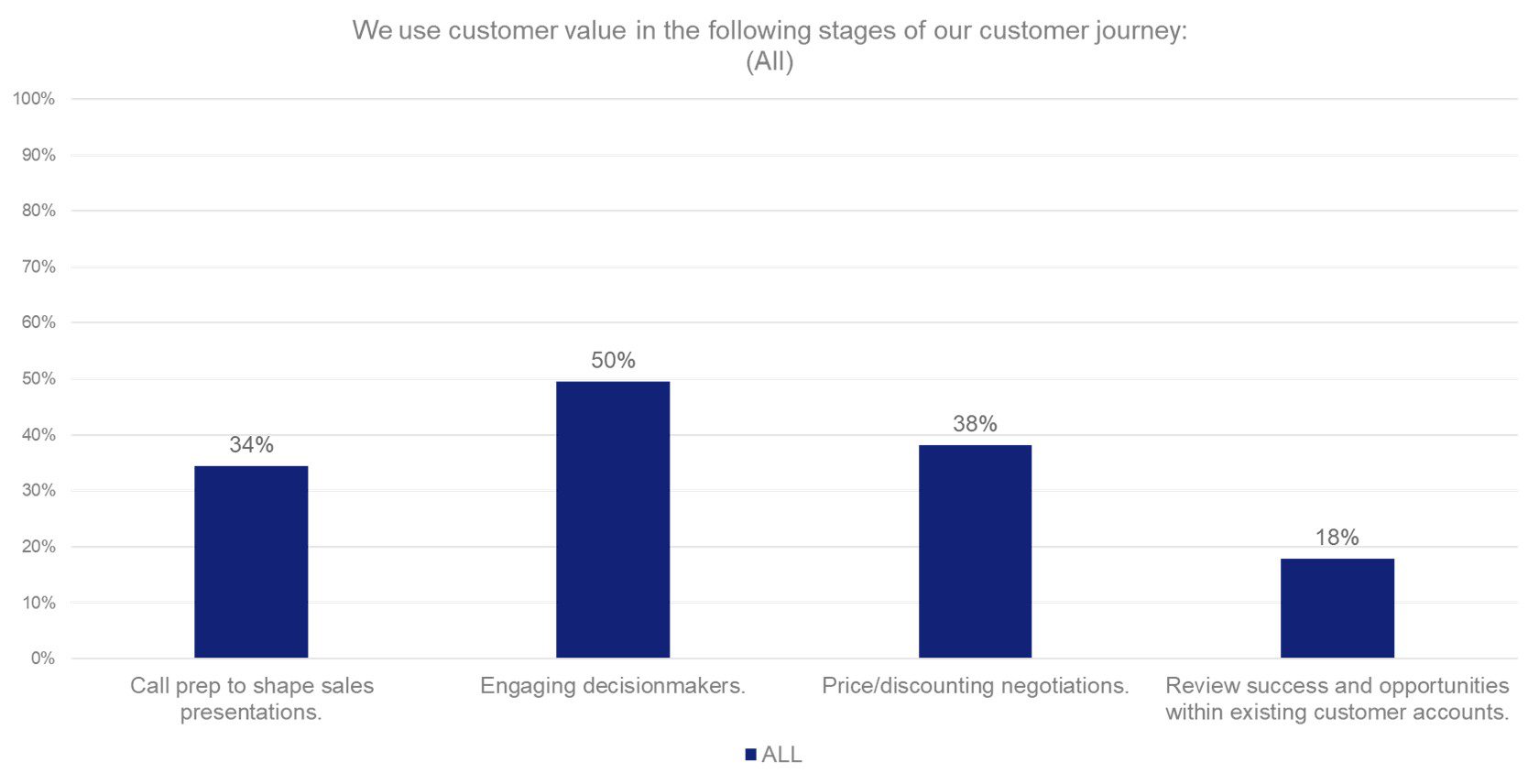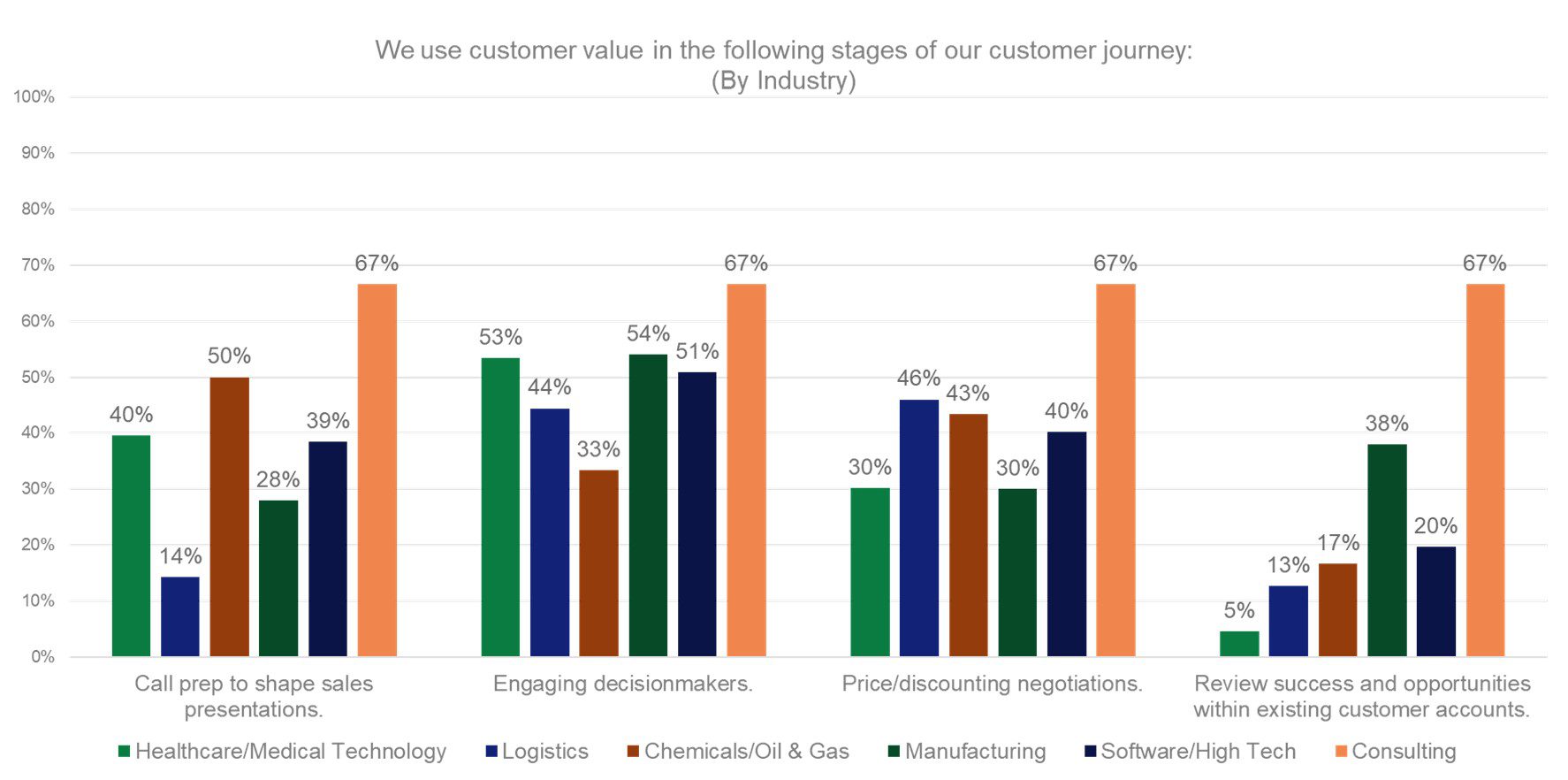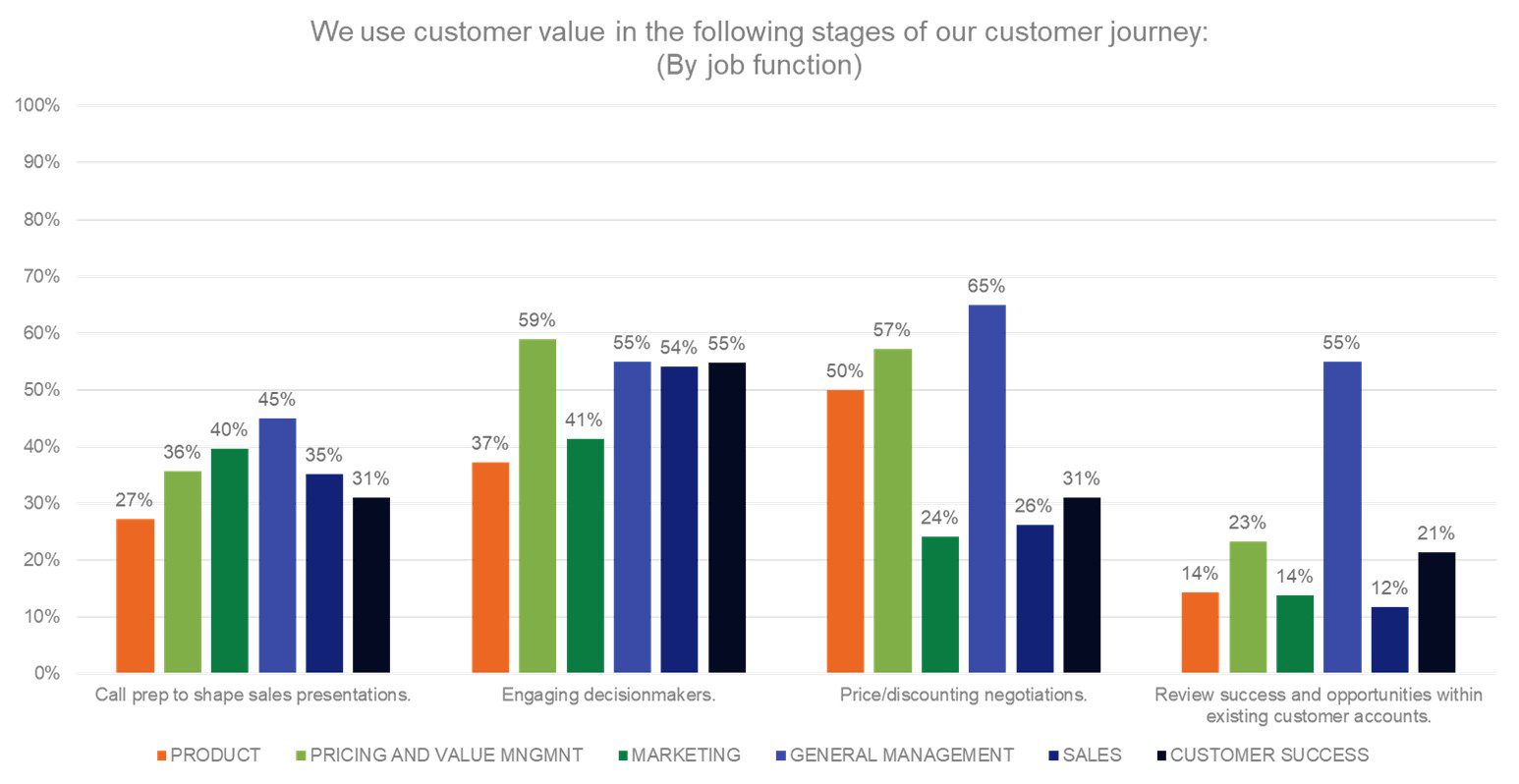Value selling is the engine that enables B2B enterprises to capture the profit impact of their customer value initiatives. In our last blog post, we explored when in the commercialization process B2B companies embed value. To realize the impact of these efforts, B2B organizations must translate their differentiated value – in the form of value-based prices and offer design – into marketing content and sales conversations. Companies that excel at this can communicate quantified value delivered across each stage of the buyer’s journey.
In one important question in the 2022 State of Value Survey, we asked respondents to indicate where in the customer journey customer value was being used (in a multi-select manner). While in an ideal world we would see 100% for each stage, learning when B2B businesses are using customer value (and more importantly, where they are not) provides an excellent snapshot of where commercial teams can optimize value communication efforts.
When looking across the board, 34% of respondents tend to use value very early in call in prep and planning customer conversations. Further along the funnel, exactly half of the respondents used it when engaging decision-makers. There was a drop-off at the next stage where 38% of respondents reported using value during price/discounting negotiations. Interestingly, and importantly, only 18% said they used value in conversations with existing accounts.

Customer Value Usage by Buying Stage
Some of our panelists were surprised at some of the findings. “I’m pleased to see that the value is being deployed at the early stage of the sales process when products have been introduced to customers and as a preparation to sales presentations,” said Ole Iacob Prebensen, Global Marketing Manager at Elkem. “However, I am a little bit surprised that the [call prep] number is not higher, but the earlier in the customer conversation value can be deployed, the less likelihood in my experience for discounts to happen. What is also a little bit surprising is the low number on the existing accounts.”
Paolo de Angeli, Head of Customer Experience and Customer Value Management at Borealis, was less surprised that value was underutilized in post-sale scenarios. “It does not surprise me so much [that the existing account number is so low], because if you think about launching new solutions, it’s easier to implement value when a product or a solution or is not in the market. When you visit an existing it is always a little bit more difficult because if you learn that you should price higher, it is hard to go back to existing customers and say, “by the way, I’ve been treating you too well for many years and now I need to increase my prices.”
Value in the Buyer’s Journey – By Industry and Job Function
Digging a bit deeper into the data, we found some interesting findings when broken apart by industry. Using this lens, we saw that consultants – many of whom had a strong value focus – were most likely to use (or recommend use) at all stages. Chemicals/Oil & Gas stood out in their use of value in call prep (50%) and price negotiations (43%), healthcare was strong early in the sales process (40% using it regularly in call prep and 53% using it in engaging decision makers), and manufacturing stood out as a relative leader in post-sale (38%).

Customer Value Usage by Buying Stage – Industry Breakout
In our previous blog, we found great variation in definitions of what a value proposition is based on job function. With that context in mind, we can also observe When slicing the audience responses by job function, we continued to find that general management had the highest degree of confidence that value was being utilized across the sales process – like our earlier findings revealing upper management’s higher degree of confidence in the success of their value initiatives than their frontline managers and contributors. In contrast, product professionals were more skeptical that customer value was considered early in the process (27%), while half reported confidence that it was being used in sales negotiations (like pricing professionals at 57%). This clashed with the perspective of sales professionals, who were most likely to use value when engaging decision-makers (54%) but less likely to use it in both call prep (35%) and in negotiations (26%).
Finally, it was no shock that – general management aside – that pricing (23%) and customer success (21%) team members were the most likely to utilize value in existing account negotiations, though the numbers were comparatively low across the board.

Customer Value Usage by Buying Stage – Job Function Breakout
Expert Lessons in Utilizing Value in the Sales Process
In discussing the importance of communicating value at each stage, our panel made a number of key observations:
-
- Value is Critical at Every Stage of the Buyer’s Journey: Our panel shared the belief that embedding value was critical across the entire sales journey for key accounts. “I think for your bigger customers – the ones you have an ongoing relationship, it has to be a hundred percent [adoption] across the board,” shared Todd Snelgrove, Founding Partner at Experts in Value “It’s great to do the call prep and prepare the PowerPoints – that’s fun – but when you get to the executive buyer and ‘you show up and throw up’ as they say, without being specific to the industry and engaging them based on their world, it’s worthless.” He summarized it well: “in my experience, my job was to say that best value is better than the lowest price, but [also] that value’s quantifiable and we’re going to measure it.”
-
- Communicate Value Early, Negotiate Later: Introducing customer value midstream in the sales process be jarring to the buyer. Ideally, sales negotiations will center around value delivered as a continuation of a longer-term value-selling dialogue “You need to create different venues to discuss value,” shared de Angeli. “You may even need to have different people around the table than the ones that you typically have negotiating your prices or your contracts. I would recommend that sales keep these two moments separate rather. If you have already invested in the years in communicating your value proposition, then the sales force should already be more comfortable and confident in selling on value and defending current price levels.”
-
- Success Stories and Case Studies: A Weapon in Negotiations: Case studies featuring similar companies – especially when the baseline quantification can help more accurately estimate financial value delivered for the account sales are trying to win. “Success stories like case studies are a great way of communicating the true financial benefit of a product or service,” shared Prebensen. “Especially when the customer unit of measure – where they use the same KPIs – is the same.”
-
- Introduce Fee at Risk in Lieu of Price Discounts: The temptation to give discounts is always a risk – especially during the end of the quarter and year when the sales team is under immense pressure to deliver revenue. By offering fee at risk, rather than discounts, sales teams are better positioned to sustain profitability in price negotiations. Snelgrove explained: “[sometimes] when salespeople get in front of the decision makers get challenged, and they are not comfortable with the numbers or the calculations, they get into negotiations and say, ‘here’s all this great value but here’s a 10% price discount.’ I think you [instead] need to have a value and price negotiation that says I will deliver more value, but I want to get paid for it.”
What does this look like in practice? “In my work with industrial companies, instead of a 10% price discount during negotiation, I am going to instead guarantee you value. We have to agree on what value is – energy savings, labor, inventory, etc. And if I do not deliver, I am going to write you a check. In two hundred global agreements that I have worked on where value was engaged part of the negotiation and was also part of tracking what actually happened, the success was just phenomenal.”
- Introduce Fee at Risk in Lieu of Price Discounts: The temptation to give discounts is always a risk – especially during the end of the quarter and year when the sales team is under immense pressure to deliver revenue. By offering fee at risk, rather than discounts, sales teams are better positioned to sustain profitability in price negotiations. Snelgrove explained: “[sometimes] when salespeople get in front of the decision makers get challenged, and they are not comfortable with the numbers or the calculations, they get into negotiations and say, ‘here’s all this great value but here’s a 10% price discount.’ I think you [instead] need to have a value and price negotiation that says I will deliver more value, but I want to get paid for it.”
-
- Implement a Value Office to Drive Alignment and Adoption: A centralized value function, whether in the form of a Value Office or a designated individual, is critical to generating sales excitement and organizational alignment around value. De Angeli shared his perspective as a leader responsible for these efforts “If you have a value management team driving these processes, it can be beneficial. For example, when we visit customers with our value workshops, I am the one facilitating them, and as a result, I am more neutral to the parties – even if marketing and technical colleagues are in the meeting. This keeps a better atmosphere for the meeting.”
- Create a Strong Culture of Value in Sales (and Beyond): In scenarios where a centralized value function is not possible, De Angeli shared the important role mobilizers can play in spreading the value gospel. “[You need] to create a culture in the company where eventually everybody owns this concept [of value]. And I know it is difficult at the beginning,” he shared. “If you think about it, your value proposition is ultimately the reason your customers bought from you and, if you wish, ultimately the reason why your company exists. It is not about only having commercial excellence initiatives – it is about getting people involved from the beginning. Sales, marketing, technical services, customer services – the more they feel they are part of the value proposition and are contributing concretely, the easier it is to implement these concepts. So, if you do not have somebody dedicated to this, you should look at least internally, somebody in the headquarters was able to connect the dots and create this culture.”
How does your organization perceive your success in value management? Check out our other posts in this series, and stay tuned for future updates as we explore perspectives on how B2B organizations deploy these value-selling techniques”:
- What is a value proposition? How do participants define value management and value selling?
- When is customer value utilized in making decisions for new and existing offerings?
- How are leading companies embedding customer value in the sales process?
- What are some useful ways for individuals and organizations to improve their value management efforts?
- Survey Overview

